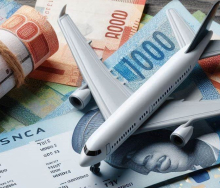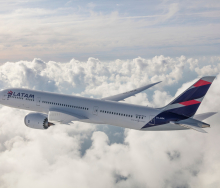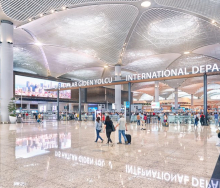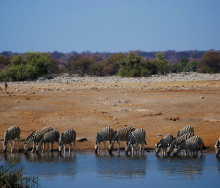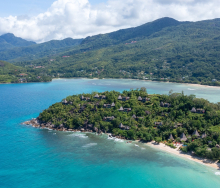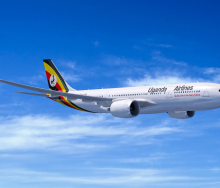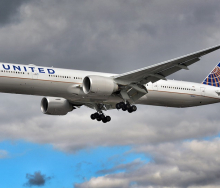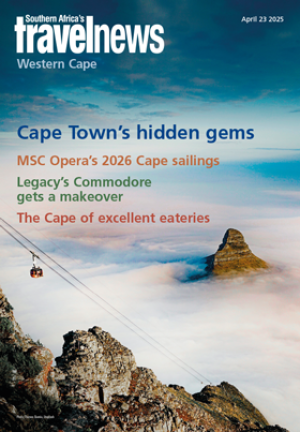More direct flights drive corporate and leisure bookings
WITH Air Madagascar
resuming flights
between South
Africa and Madagascar in
June, agents and airline
representatives report an
increase in enquiries for both
Antananarivo for corporate
travellers and Nosy Be for
leisure travellers.
Air Madagascar’s flight
departs from Johannesburg
on Tuesdays and Sundays
at 07h30, arriving in
Antananarivo at 11h25.
Flights return on Mondays
and Sundays departing from
Antananarivo at 15h05 arriving
in Johannesburg at 17h25.
Airlink operates daily direct
flights to Antananarivo,
departing Johannesburg
at 10h00 and arriving at
14h00. The return flight
departs at 14h45, arriving in
Johannesburg at 17h10.
It also offers a Sunday
flight to Nosy Be, departing
Johannesburg at 09h30 and
arriving at 14h00. The return
flight departs from Nosy
Be at 14h45 and arrives in
Johannesburg at 18h45.
Rove Africa sales and
marketing director, Lance
Zackey, says: “We specialise
in marketing Nosy Be as
a destination because of
Airlink’s direct flights to
the island but, with Air
Madagascar resuming flights,
a lot of opportunities have
opened up to travel across the
island, which benefits wildlife
lovers in particular.”
Airlink marketing and sales
manager, Karin Murray, says
there has been a definite
improvement in booking
trends for both the Nosy Be
and Antananarivo flights. “We
attribute this to improved
political stability and the
concomitant increase in
business activity and leisure
tourism.”
Both Karin and Carla da
Silva, Air Mauritius regional
manager for Southern Africa
and Latin America, say the
Antananarivo market is mainly
driven by corporate traffic
from the agricultural, fisheries,
textiles and mining industries.
Carla says Air Mauritius has
seen a steady flow of traffic to
Madagascar, with daily flights
from Cape Town, Johannesburg
and Durban via Mauritius and
onwards to Antananarivo.
The Nosy Be market, on the
other hand, is predominantly
driven by leisure traffic.
“The Nosy Be Archipelago is
situated off the north-west
coast of Madagascar, with
popular beach resorts, unique
wildlife, numerous smaller
islands, untouched coral reefs,
and amazing snorkelling and
diving,” says Karin.
Isla Moffett, commercial
manager for GSA Border Air,
representing Air Madagascar,
says Madagascar leisure
travellers tend to fall into
niche sectors, such as fishing
enthusiasts, surfers and bird
watchers.
Karin says, while Airlink
does not provide scheduled
services within the domestic
network in Madagascar, it
is on the cards. Once there
is a signed agreement with
the Malagasy government,
Airlink intends to explore
these options alongside
Malagasy partner group,
Sipromad. “Airlink will continue
monitoring the Madagascan
travel and tourism markets
and we are ready to consider
new destinations directly
from Johannesburg, such
as Tamatave, Toliary, Diego
Suarez and Fort Dauphin,”
says Karin.
Air Madagascar currently
offers codeshare flights and
through fares to several
domestic destinations via a
codeshare with subsidiary
Tsaradia.
Book it!
G Adventures is offering a 14-day Highlights of Madagascar tour from R27 459pps. It includes a guided
walk to experience lemurs and other unique wildlife, visits to world-famous national parks, local artisan
workshops and time to lounge on beautiful beaches. The tour includes three meals a day and comfortable
tourist-class accommodation. Expect to go on guided walks in Andasibe Indri Reserve and Anja Reserve,
visit an artisan workshop, a traditional healer, a paper factory and Isalo National Park. This price also
includes transport to and from included activities.
Primates and pristine beaches
ROUGHLY three hours’ drive
from Madagascar’s capital,
Antananarivo, lies Vakona
Forest Lodge.
This charming Malagasy
bungalow accommodation
is spread out across a
eucalyptus plantation. The
lodge has its own in-house
reserve where guests
can interact with a variety
habituated lemurs who will
climb all over you if you
smell vaguely of bananas.
The nearby Andasibe
National Park is one of the
best places in Madagascar
to spot lemurs in the wild
and is home to the rare,
large, fuzzy Indri lemurs that
can be heard howling eerily
to one another at sunrise
as they swing from branch
to branch in the treetops
overhead. Guided tours of
the reserve can be arranged
by the lodge.
Although hotel airport
transfers can be booked
directly through Vakona
Lodge it is recommended
to rather book all
accommodation, sightseeing
and transfers through a
single tour operator to avoid
itinerary interruptions and
missed flights.
Located directly on the
beach in the west of Nosy
Be, Chanty Beach is a great
option for travellers wanting
to explore Madagascar on
a budget. A retired German
businessman and his
Malagasy wife were the
perfect hosts, arranging
breakfasts under pergolas
overlooking the beach and
assisting in negotiations
with local ferrymen and
speed boat/tour guides on
behalf of their guests.
It is easy to while away
long days on the beach
at the lodge or to arrange
speedboat tours to the
various islands on the
archipelago. There are
options to visit lemur island
sanctuaries, shop for crafts
in local village markets,
snorkel coral reefs with
sea turtles or go for long
walks along deserted island
beaches.
A real highlight is the ferry
ride that Chanty Beach’s
owner organises to a nearby
island where a rustic café
serves a Sunday seafood
buffet on the beach.
Lobsters, crab, prawns,
mussels, calamari and fish
are plentiful for a fraction of
the cost of a buying a plate
of prawns in South Africa.
It is also possible to
enjoy sunset strolls from
Chanty Beach, stopping
in at any of the nearby
resorts for dinner in a
different restaurant every
day. The nearby Coral Noir
Resort and the Vanilla Hotel
and Spa are particularly
recommended.
A wildlife lover’s bucket-list trip
MADAGASCAR’S ecological
diversity has led some
scientists to refer to the island
as ‘the eighth continent’. It
is home to a dizzying array of
plants and animals, with over
615 new species discovered
on the island between 1999
and 2010.
Lemurs
There are more than 70
species and subspecies of
lemurs living across the island.
The latest one was discovered
as recently as 1985.
Perhaps the most beautiful
and captivating of the lemurs
is the ‘angel of the forest’ – or
Silky Sifaka. A large lemur with
white fur, it is one of the rarest
animals in the world.
The Silky Sifika population is
estimated to be anything from
100 to 1000 individuals. They
are only found in the wild, with
none in captivity. The animal
is the flagship species for the
protected areas where it is
found, some of which have
been inaugurated as part of
a World Heritage Site cluster
known as the Rainforests of
the Atsinanana. The majority of
the remaining population are
found in Marojejy National Park
and Anjanaharibe-Sud Special
Reserve.
Rove Africa’s Lance Zackey
says lemur tracking is a big
drawcard for Madagascar. “It
is the only place where lemurs
are endemic, with different
species found in different
parts of the island.”
More well-known species
of lemur in Madagascar
include the ring-tailed lemur,
popularised through the
DreamWorks film franchise,
Madagascar. This lemur is
highly social, living in groups
as large as 30 individuals.
The Isalo National Park in the
south-west of Madagascar
is one of the best reserves
where tourists can spot
this lemur together with
Andohahela National Park
and Andringitra National Park.
Lemur sanctuaries are also
scattered around the island.
Birding
The diverse birdlife makes the
island a great destination to
tick off some of the world’s
rarest bird sightings.
Malagasy tour operators
recommend visits to Lake
Alarobia to see Malagasy pond
herons. The seldom-visited
Betsiboaka Delta is home to
two of Madagascar’s rarest
birds – the Bernier’s Teal
and the Madagascar Sacred
Ibis – and the Madagascar
Grebe can be spotted in the
Tsimbazaza Zoo.
Experts say Malagasy
rainforest birding is best in the
early spring and early summer
between the end of August
and late December.
Book it!
Airlink is offering flights from Johannesburg to Antananarivo from R10 165 and from Johannesburg to
Nosy Be from R13 586. Rates are inclusive of taxes and levies.
Fishing in Madagascar
MADAGASCAR not only
offers breath-taking wildlife,
but also incredible fishing
opportunities at sea,
particularly off the coast of
the small island of Nosy Be.
Game fishing for sailfish,
dorado, yellowfin tuna and
marlin is particularly good in
the area.
Madagascar Fishing
Adventures spokesperson,
Sue van der Toorn, says
business picked up in
Madagascar – particularly
in Nosy Be – after Airlink
brought in its direct flight.
She says that the Blue
marlin fishing in the region
is incredible, and says the
island is untarnished by
over tourism.
“It is unspoilt and
beautiful. The sea is clear
and flat, making it easy to
find fish, and means that
people don’t experience a
lot of seasickness.”
Sue says Madagascar
is a reasonably priced
destination and is good for
both groups and families.
However, she cautions
against travel during cyclone
season from December to
March.

